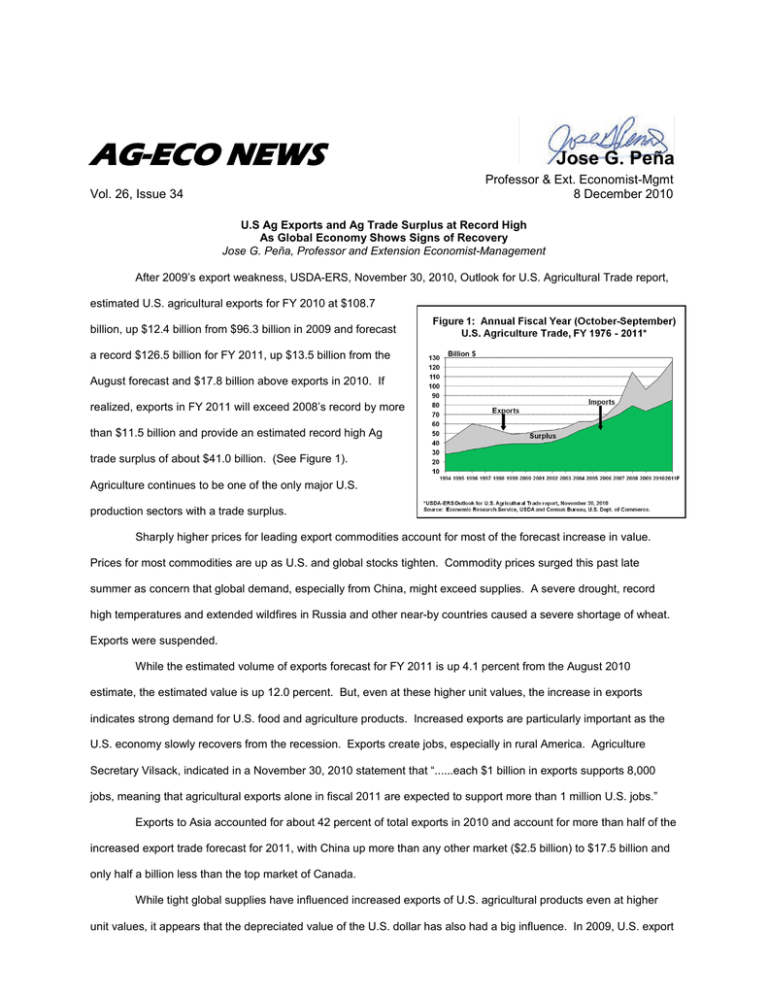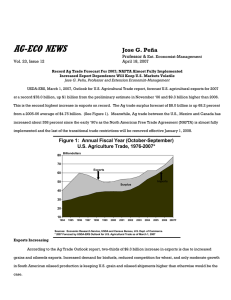AG-ECO NEWS Jose G. Peña
advertisement

AG-ECO NEWS Jose G. Peña Professor & Ext. Economist-Mgmt 8 December 2010 Vol. 26, Issue 34 U.S Ag Exports and Ag Trade Surplus at Record High As Global Economy Shows Signs of Recovery Jose G. Peña, Professor and Extension Economist-Management After 2009’s export weakness, USDA-ERS, November 30, 2010, Outlook for U.S. Agricultural Trade report, estimated U.S. agricultural exports for FY 2010 at $108.7 billion, up $12.4 billion from $96.3 billion in 2009 and forecast a record $126.5 billion for FY 2011, up $13.5 billion from the August forecast and $17.8 billion above exports in 2010. If realized, exports in FY 2011 will exceed 2008’s record by more than $11.5 billion and provide an estimated record high Ag trade surplus of about $41.0 billion. (See Figure 1). Agriculture continues to be one of the only major U.S. production sectors with a trade surplus. Sharply higher prices for leading export commodities account for most of the forecast increase in value. Prices for most commodities are up as U.S. and global stocks tighten. Commodity prices surged this past late summer as concern that global demand, especially from China, might exceed supplies. A severe drought, record high temperatures and extended wildfires in Russia and other near-by countries caused a severe shortage of wheat. Exports were suspended. While the estimated volume of exports forecast for FY 2011 is up 4.1 percent from the August 2010 estimate, the estimated value is up 12.0 percent. But, even at these higher unit values, the increase in exports indicates strong demand for U.S. food and agriculture products. Increased exports are particularly important as the U.S. economy slowly recovers from the recession. Exports create jobs, especially in rural America. Agriculture Secretary Vilsack, indicated in a November 30, 2010 statement that “......each $1 billion in exports supports 8,000 jobs, meaning that agricultural exports alone in fiscal 2011 are expected to support more than 1 million U.S. jobs.” Exports to Asia accounted for about 42 percent of total exports in 2010 and account for more than half of the increased export trade forecast for 2011, with China up more than any other market ($2.5 billion) to $17.5 billion and only half a billion less than the top market of Canada. While tight global supplies have influenced increased exports of U.S. agricultural products even at higher unit values, it appears that the depreciated value of the U.S. dollar has also had a big influence. In 2009, U.S. export trade slowed significantly as a result of the global recession and the appreciated value of the U.S. dollar. Now, a weaker U.S. dollar, especially since spring 2010, is encouraging exports . (See Figure 2) While a weakening U.S. dollar aggravates the U.S. deficit/debt since more lowered valued dollars are required to purchase imports, a cheaper U.S. dollar makes U.S. export commodities, such as corn, cotton, beef, etc., cheaper to overseas buyers, even at current increased prices. Increased exports will help boost the economic recovery which is underway. World demand for U.S. commodities remains strong. Increased Exports According to USDA-ERS, November 30, 2010 Outlook for U.S. Agricultural Trade Report, the FY 2011 export trade forecast was increased substantially for most U.S. commodities (except horticultural products) from the initial August 2010 estimate. • The export forecast for grain and feed was raised $3.9 billion from August to $35.4 billion, the second highest on record. • The wheat export forecast was increased by $1.7 billion to $9.8 billion on sharply higher volumes and unit values. • The forecast for oilseeds and products was increased to $28.3 billion, up $6.3 billion. Soybeans account for three-quarters of the increase as record early season sales and a dramatic rise in unit values added $5.1 billion to the export forecast. • Cotton exports are forecast up $2 billion to $8 billion due primarily to higher unit values. • The export forecast for livestock, poultry, and dairy was raised $1.2 billion to $23 billion, with gains in all but poultry. • The export forecast for horticultural products was lowered $200 million from the August forecast, but remains a record at $24.3 billion. Increased Imports USDA-ERS November 30, 2010 Outlook for Export Trade report also increased the import forecast to $85.5 billion, up 8.2 percent from FY 2010 as consumer spending for food and beverages has increased recently, as has disposable personal income. The projected import growth in 2011 reflects about 2-3 percent volume gain and a six percent increase in import unit values. Major commodities inflating the U.S. import value include coffee beans, cocoa beans, coconut oil, palm oil, rubber, and sugar. NAFTA While trade among North American Free Trade Agreement (NAFTA) trading partners weakened slightly in 2009 as the global recession slowed international trade, the trend of improved trade among NAFTA partners resumed this year. U.S. export trade to NAFTA partners during FY 2010 at $30.5 billion was the second highest on record. (See Figure 3) The FY 2011 export forecast to NAFTA partners, Mexico and Canada, is up $2.6 billion from 2010. Trade with our two NAFTA trading partners reached a record high in 2008 as the agricultural provisions of the agreement were fully implemented. During the implementation period, the agricultural sectors of Canada, Mexico, and the U.S. have become much more integrated. While Mexico moved slightly below rd China to the 3 largest export destination in the USDA-ERS November export forecast for 2011, Canada remains the largest export market for U.S. agricultural products. U.S. agricultural exports to Mexico more than tripled since NAFTA was implemented in 1994 to about $16.0 billion in FY 2010, while exports to Canada increased about 360 percent, reaching $16.7 billion in FY 2010, up from $4.2 billion in 1990. Fresh and processed fruits and vegetables, snack foods, and other consumer foods account for close to three-fourths of U.S. sales to Canada. Imports from Canada increased from $3.2 billion in 1989 to $15.682 billion in FY 2010. Appreciation is expressed to Dr. Parr Rosson, Extension Economist Director, Center for North American Studies for his contribution and to review this article.







